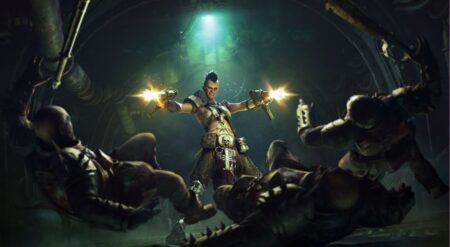It may have only been four years since Battlefield 2042, but for fans of the genre-defining military shooter, they have been waiting even longer to go back to the franchise’s core gameplay. Called a spiritual successor to Battlefield 3 and Battlefield 4, Battlefield 6 multiplayer is loud, kinetic, and balances both large-team strategic play with small-team firefights.
The premise of Battlefield 6 is familiar. Set in 2027, a high-profile assassination has changed the global landscape. Most of the European countries have left NATO, leaving the United States to grapple with the fallout of it all. PAX ARMATA, a military organization with extremely deep pockets, has risen to power while NATO is left in shambles. Still, the remnants of NATO’s forces are now Dagger 13, left with a strong resolve and an even firmer alliance between the remaining countries.
While Battlefield 6 will feature a full solo campaign, multiplayer is where the franchise has shone and where blemishes have been revealed. During the Battlefield 6 multiplayer reveal event, press and streamers were given four hours with the game, playing through four different game modes: Conquest, Squad Deathmatch, Breakthrough, and Domination. At launch, Rush, Team Deathmatch, King of the Hill, and Escalation will round out the eight available game modes in Battlefield 6 multiplayer.
Our time with half of the Battlefield 6 multiplayer highlighted what to expect from the game’s signature approach to large-scale combat and its new take on close-quarters firefights. With Squad Deathmatch, multiple squads face off against each other, aiming to reach the highest number of kills over the others. Domination is a tried and true classic, with players aiming to control three different points for the longest amount of time.
Battlefield 6 multiplayer brings back classic game modes and expands into modes that define the genre itself.

With four-man squads, the focus is on class distribution across the game’s returning four: Assault, Engineer, Recon, and Support. This is where team-comp makes the largest difference. Battlefield 6 multiplayer shines in these takes on FPS staples, and that is due in large part to the developers’ approach to map design.
Our time with the game took us to four of the game’s maps, all of which transport us to real-world locations. The Siege of Cairo offers urban combat and an increased focus on close-quarters warfare, pushing you to clear rooms and watch the windows.
Empire State of Mind, Battlefield 6 multiplayer’s US-based map set in Brooklyn, isn’t about vehicles; it’s all infantry only and pushes you into direct confrontation. Iberian Offensive takes players to Gibraltar, which offers the most when it comes to building destruction, with open streets and few two-story offerings. Navigating streets and communication make the difference.
And finally, Battlefield 6 multiplayer takes us to the snow with Liberation Peak in Tajikistan. Set within a mountainside, this map makes height advantage a priority and thrives when it comes to vehicles. In addition to the maps we played, Battlefield 6 multiplayer will launch with five more, which include Battlefield 3‘s Operation Firestorm.
Each small-scale battle is confined to a Combat Zone within a larger map. While this does lead to some moments where you are directed back to the main area if you venture too far, it also means learning Battlefield 6 multiplayer maps easily comes with repetition. Where the signature large-scale warfare takes up the entire map, the Combat Zones take over complex smaller sections that take some of each map’s most interesting points, often buildings and confined areas.
However, even though each of the maps is essentially the same, the variation between the large-scale and the small-scale feels drastically different. This is due to the resources at your disposal, your use of gadgets, and, of course, the ease of being discovered. The approach to both types of modes works exceptionally well and rewards the player for learning the ins and outs of the space.
Breakthrough and Conquest feel just as good as they did in the older titles.
On the large-scale side of things, Breakthrough and Conquest are thrilling to say the least. Each overwhelming in their own interesting ways, the complexity added with expanded tactical destruction becomes key. With players able to change the map to suit their needs by destroying walls, fortifications, and the like, a game can shift easily even if you’re in the lead.
The expanded tactical destruction raises the importance of learning how to pilot vehicles, where the refined and more accessible navigation system for them makes it more approachable for players to explore. But where does the tactical destruction really prove itself? Taking on the Recon class.
For the snipers of the group, it’s no secret that posting up and camping in just the right spot can earn a sniper killstreak that can build to overwhelm their opponents. But you can’t camp if the entire side wall of your favorite window is destroyed, or you know, if the entire building just comes down. Battlefield is a franchise known for breaking stuff, but in Battlefield 6 multiplayer, you break stuff with intention, and it pays off.
During the presentation, the dev team highlighted their four pillars: Class, Gunplay, Vehicles, and Destruction. And in the Battlefield 6 multiplayer modes we played, you can see how the team’s uncompromising approach affected each of them. To put it simply, it just feels good.
When it comes to classes, the four are par for the course, but that doesn’t make them bad. Assault is focused on being the first into a room. With an assault rifle as the primary weapon, this class is faster to aim and shoot while sprinting than the other classes. The only class to have a secondary weapon that isn’t a pistol, the class is designed to punch through the front line with either frag grenades, smoke, or flash, as well as a grenade launcher that can either shoot a devastating blast at a distance or deploy an incendiary coating the ground in DOT fire.
In addition to your arsenal, each class is also outfitted with a special gadget, signature trait, and active ability. For Assault, the special gadget is an adrenaline injector that removes effects from stun and smoke grenades, boosts sprint speed, reduces explosive damage, and makes enemy sounds more audible.
Used in conjunction with the Assault class’s active ability, which reveals audible enemies on the mini-map, it’s a great one-two-punch for your frontline. Additionally, all of this is impacted by Assault’s signature trait, which reduces damage and movement speed penalties after a fall.
Assault was the most used class during the preview event, and there’s a reason for that.

In addition to everything I just mentioned, each class also features trainings that allow players to specialize in their class, adding diversity to team comps even if there are multiple of them on one squad. For Assault, those two trainings were Grenadier, which allows players to carry more grenades and reload their launcher faster, as well as provides a buff that reduces the impact of flash effects.
Assault was where I was happiest. While the damage is reduced compared to other classes as a balance measure, the speed makes the class extremely viable, even if the shotgun does way more to eliminate others in close-quarters fights than the rifles ever do. In fact, Assault classes dominated most of the lobbies I was in.
That said, Battlefield 6 multiplayer balances this clear player-favorite by allowing the Assault class to use their adrenaline injectors on other players to provide relief to Support players. Assault players pick up the downed teammate and inject them after a countdown. While this kind of healing often leads to a bad time for both involved, and reduces the inclination to resuscitate downed players, Battlefield 6 multiplayer allows you to drag your teammates into cover without restarting the countdown to when you heal them.
It is the single factor I have craved in absolutely any FPS game, and it works extremely well, especially in game modes like breakthrough, where waves of enemies just keep coming and pushing you back to your HQ, often leaving you extremely exposed and pressed by the enemy.
An Engineer functions as a support class (not THE Support class) for the team. The class is built to become a menace when played on maps that benefit from controlling the streets with vehicles. Engineers can sabotage enemy vehicles and repair friendly ones with their signature gadget, the repair tool. With a signature SMG, the class has improved hip-fire control, and their signature trait buffs them against explosive damage.
When it comes to the training for this class, Engineers can pick between Anti-Armor or Combat Engineer. The former is focused on destroying enemy vehicles and buildings with rockets, as well as carrying extra ammunition and reducing reload time for the rocket launchers.
Engineers will be the underrated unsung heroes of Battlefield 6’s classes.

The latter isn’t about destruction but restoration. Combat Engineers are natural in a vehicle, auto-generating health for the vehicle that they pilot, making them essential in modes like Conquest and Breakthrough. Additionally, their repair tool can be used for longer before overheating, and they can spot enemy mines.
Recon is my mortal enemy. As mentioned before, these are the snipers, but it’s not just that. This class is focused on building information for the rest of their squad to help with infiltration. The sniper rifle is their obvious signature weapon, and because of that, they reload faster and have better breath control to stabilize their shots for longer.
The Recon class signature trait is vile (complimentary), allowing them to spot enemies when looking through an optical scope automatically. As for gadgets, this class deploys a motion sensor that can track enemy movement, best used for entry ways into two-story buildings and to make sure you’re not flanked on more open maps like Tajikistan. Additionally, Recon players can also call a UAV to a specific location, revealing enemies to the squad.
The two training paths for Recon are Sniper and Pathfinder. Snipers don’t just nail you with one shot; if they don’t hit the headshot, these long-range specialists’ shots will stop healing, highlight enemies, and ultimately, if they do nail you in the dome, make you unrevivable.
While the dev team called Engineers the menace of the classes, Recon is where all of my headaches came from (pun intended). On the other side, Pathfinder specialized Recon players are undetectable by equipment unless they are sprinting, highlight enemies for the rest of the team when they land a shot, and perform more silent take-downs.
Recon is Battlefield 6 multiplayer’s menace, but tactical destruction is there to even the score.

And finally, Battlefield 6 multiplayer MVP, Support. The healing class, Support, is all about setting up and laying fire to take care of your teammates. The signature weapon is a Light Machine Gun, and Support is the only class that doesn’t get a sprint penalty with this weapon type.
Additionally, Support comes in clutch and can drop a supply bag as their signature gadget, which passively heals allies and resupplies weapon and gadget ammo. As for their active ability, Support supplies an AOE around themselves that allows revive speed to increase.
When it comes to their training specializations, it’s Combat Medic or Fire Support. Combat Medic essentially functions as a health dispensary for allies to regenerate health when around, reviving squadmates. As for Fire Support, this kind of Support player has improved weapon control from a mounted position and can provide ammo for teammates.
Now that we’ve talked about classes, the important thing is how they play, and to be honest, the gunplay mechanics have been designed with kinesthetic gameplay in mind. This allows you to have more control over your gameplay and tactics, and honestly makes the largest difference in keeping a fast pace to battle, whether you’re in a match with many or few.

This looks like dragging and reviving your teammates, mounting weapons to decrease recoil, combat rolls to reduce damage, hitching a ride on vehicles on the outside to stick with your team, and then, peak and lean. It may seem like an extremely small element of gameplay that allows you to auto-peek around corners and essentially trains you into the habit of being aware of your surroundings. It pulls you into an easier practice than jiggle peaking, but performs the same function, making it accessible to newer players or, if you’re like me, players who are returning after years and years away.
According to the devs, this kind of gameplay is also designed to teach the player over time throughout live play instead of siloing people into tutorials. One of the ways that you learn to use the weapons in this way is the slight tilt that is applied as you move and focus.
The combat system is intuitive and familiar, but the class systems are innovative enough to stand out well against the existing offerings on the market. While we didn’t get to play it, the one game mode that seemed to highlight that is Escalation. New for Battlefield 6 multiplayer, Escalation is essentially the point of everything. It pulls all of your skills into one experience.
In Escalation, two teams fight to capture strategic points, and as each team expands its territory, fewer and fewer control points exist for capture. This kind of design forces players into an “all-out war” that forces them into a mix of strategy and chaos as they push to control the map.
The Battlefield 6 multiplayer reveal sets the tone for a game that’s doubling down on what made the franchise great, and shows it’s still innovative.

Between the two genre juggernauts, Battlefield has always been more focused on strategy and team communication, facilitated by its large team format. Compared to its competitor, this defining factor is what has been a make-or-break for players: do you want to play at a massive scale, or do you want a high-paced firefight on a small nuclear test town? And in all honesty, I have been in the latter category.
That being said, Battlefield 6’s multiplayer already feels like an improvement that makes the game appeal to every kind of player, tapping into the audience that has been dominated by one game and playstyle. But more importantly, the game itself pushes you to learn its systems, rewards you for doing so, and makes sure that you have fun while doing it.
The balance that the teams who worked on the game have been able to achieve between all game modes, the kinetic pace they’ve set, and the way that you can manipulate the maps makes for a multiplayer experience that shows that they are coming directly for the top of the genre. It also shows exactly why Battlefield has been so revered throughout the years.
With so much more to uncover as launch gets closer, elements like the Portal, which allows players to create their own maps with no restrictions on reality, which runs on Godot, and more maps to see, not to mention the solo-campaign content, Battlefield 6 is big.
Battlefield 6 multiplayer is an aggressive take on the military FPS, and everything matters. It’s not about things looking good or fun; it’s about how everything comes together. The entire environment is your playground, and with class specializations and tactical destruction, boredom isn’t something to worry about.
If you’re a veteran Battlefield player or someone just looking for a new FPS to push others in the space, Battlefield 6 multiplayer is that. The teams at Battlefield Studios, Criterion, DICE, Motive, and Ripple Effect have crafted a multiplayer experience that remembers what made the franchise one of the tentpoles of the genre, but also adapted to meet players where they are right now. Now, they just need to stick the landing.
Battlefield 6 launches on October 10, 2025, on PlayStation 5, Xbox Series X|S, and PC.
Early access begins for its open beta on August 7-8 for those who have signed up for Battlefield Labs, and the open beta starts for everyone on August 9-10 and then again for a second weekend from August 14-17.








